And its civilizing forces.
These pieces generally run annually in time for Hanukkah and Christmas.
The images below are in chronological order, illustrating key junctures in the progression of western art and architecture.
No one exposed me to the visual world. My parents had little interest in the visual arts, being more focused on music. Chopin’s piano music was the first thing I recall hearing as a child, emanating from the gramophone, played by Artur Rubinstein, naturally. You can take a Pole out of Poland but you cannot take the Polish out of a Pole. My parents, whose world view stopped at the Russian border on the east and the German one in the west – and they were to experience occupation by both aggressors – saw to it that refugee status would have them end up in England, not the United States. Had they given but one moment of thought to this decision, I would have graduated from the Ivy League not University College, London. My loss. It always does to choose one’s parents well.
No, my exposure to the visual world, by which I mean painting, photography and architecture, was purely the result of serendipity. I chanced on the photography section at the Kensington Public Library at a very early age, still in short trousers, and in retrospect I started at the top, for the first photographs I seriously studied were those of Henri Cartier-Bresson whose greatest work was done in the 1930s. My interest sparked, I went on to explore the wit and whimsy of the fashion photography world, once again lucking out and starting at the top in the guise of Irving Penn, who conquered this and many other genres with aplomb. Not surprisingly during these early years of discovery Paris and the French came to my notice and when I visited Paris in 1973, poor as the proverbial church mouse, it was with two goals. To take street snaps and to visit the Louvre. In the process I fell head over heels in love with France and the French, a nation whose greatness looked askance at the small minded provincialism of the British and their hatred of all things foreign. And that does not even take into account that assault on food which is British cooking. For centuries the French have welcomed free thinkers, revolutionaries and non-conformists, not to mention those who prefer to eat well.

The Mourning of Christ, 1306. Giotto. Perspective was still awaiting discovery.
My early interest in French culture saw me devour Proust’s magnum opus “In Search of Time Past” not once but twice while still a teenager. And that second reading, during my last years at prep school, coincided with a transforming experience which greatly broadened my appreciation of the visual world. That event was the BBC’s series “Civilisation” written and narrated by Kenneth Clark and enthusiastically sponsored by the head of the BBC, David Attenborough. Even fifty years later it’s accurate to say that Clark was the premier art historian of the past century.
Suddenly, a world which had been limited to Delacroix, Ingres, Géricault, Degas, Pissarro, Sisley, Manet, Monet, Corot, Daumier, Gauguin, Cézanne, Rodin, Seurat and Van Gogh exploded to include Giotto, Titian, Botticelli, Giorgione, Mantegna, Leonardo, Michelangelo, Raphael, Bernini, Brunneleschi, Bramante, Donatello, Caravaggio and Tintoretto – Italians all – and the realization that Florence, Venice and Rome, the cities at the heart of the 15th and 16th century Renaissance, had contributed the bulk of what we know about art and architecture in Western Europe to this day. And all of this against the most frightful background of despotic rulers and corrupt popes who left us with this great legacy which is Civilisation.
Or, as Harry Lime/Orson Welles put it in Carol Reed’s ‘The Third Man’: “You know what the fellow said – in Italy, for thirty years under the Borgias, they had warfare, terror, murder and bloodshed, but they produced Michelangelo, Leonardo da Vinci and the Renaissance. In Switzerland, they had brotherly love, they had five hundred years of democracy and peace – and what did that produce? The cuckoo clock.”
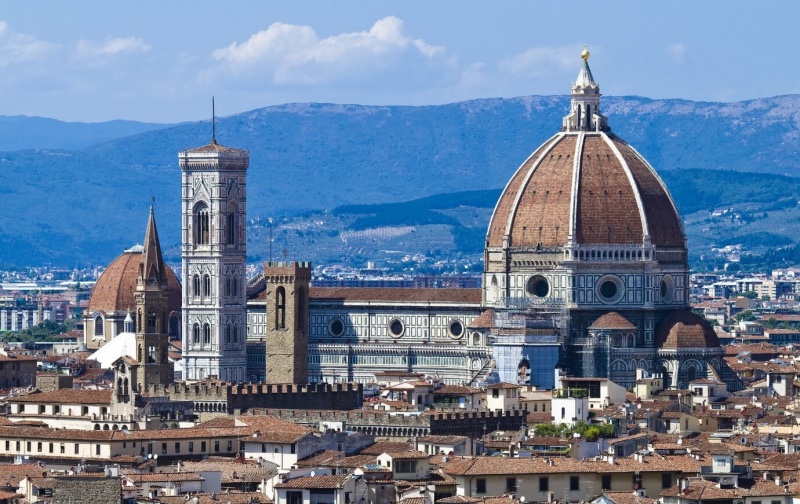
Florence Cathedral, 1294 – 1436 by Brunneleschi.
The Italians were not just great designers. They were also magnificent engineers.
Contrast the severity here with the ornate detail of St. Peter’s.
All of this discovery was ably guided by Lord Clark’s mellifluous prose and, despite his magnificent erudition, not for one moment is there an iota of condescension. Clark was, above all, a great teacher, looking to share his knowledge, not take advantage of it. Stated differently, his patrician roots and superb education at Winchester and Trinity College, Oxford, where history was his major, empowered rather than constrained his communication skills. That he only earned a second class degree is merely a reflection of the fact that his burning interest even at this early age was focused on art, not history. And socially, while he would always be talking down to his audience, as a great humanist he only ever communicated on their level.
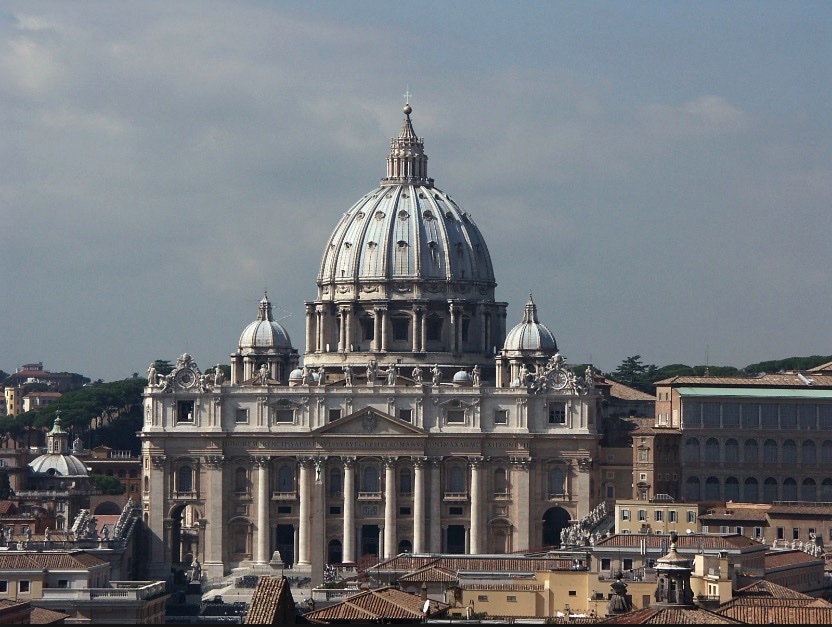
St. Peter’s Basilica, Rome, 1505 – 1626. Bramante was
the primary architect of the greatest church in Christendom.
Seen from Castel Sant’Angelo.
St. Peter’s was commissioned by Pope Julius II. Clark writes of the Pope:
…. we see for the first time the splendid head of the young cardinal who, more than any man, was destined to give the High Renaissance its heroic direction, Giuliano della Rovere. What a lion he looks compared to the donkeys of the papal secretariat! And when he became Pope Julius II he was able by magnanimity and strength of will to inspire and bully three men of genius – Bramante, Michelangelo and Raphael. Without him Michelangelo would not have painted the Sistine ceiling, nor Raphael decorated the papal apartments; and so we should have been without two of the greatest visible expressions of spiritual power and humanist philosophy.
And, one might add, St. Peter’s would have come out looking like the local parish hall instead of what it is, the most glorious church in all Christendom.
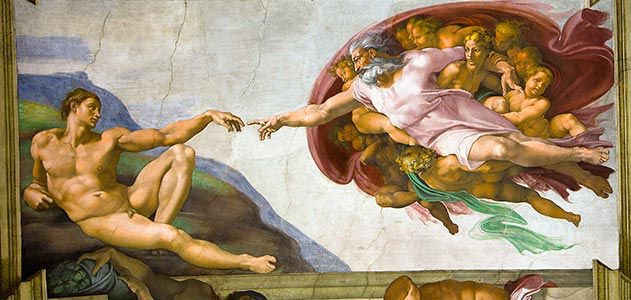
The Creation of Adam, detail of the Sistine Chapel, 1483.
Michelangelo’s tribute to himself, and a masterpiece of humanism.
History suggests that Julius II, the warrior Pope, was a good deal less saintly than Clark would have us believe, but there’s no denying he was the driver behind the rebuilding of St. Peter’s as well as the subject of Raphael’s finest portrait. His was the decision to raze the old basilica, committing to the century long project that is today’s headquarters of the Catholic faith. Even if one condemns all religion as utter bunk, the greatest confidence trick since the origin of the earth and the source of most of the deadly conflicts of the past two millennia, it would be churlish indeed to deny the genius that is St. Peter’s.
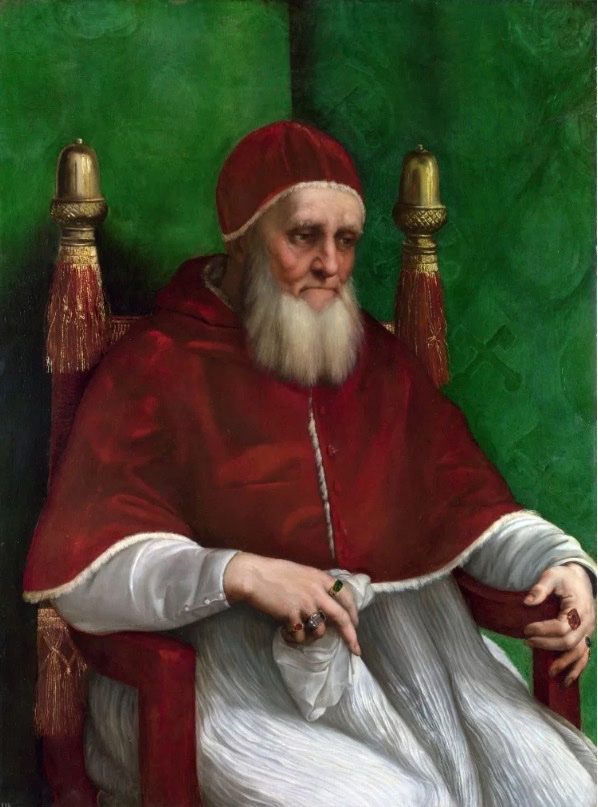
Pope Julius II, 1512 by Raphael.
The single greatest portrait of the Renaissance.
The BBC series, the first of its kind in color and filmed on costly 35mm stock at that, was in thirteen parts and I have just watched all the episodes once more. The grainy video shows its age and is not really up to the big, sharp TV screen of today, but Clark’s prose has not aged. Here he is in the last episode, ‘Heroic Materialism’, which speaks to the Industrial Revolution and the rise of the New World:
“On the whole I think that knowledge is preferable to ignorance, and I am sure that human sympathy is more valuable than ideology. I believe that in spite of the recent triumphs of science, men haven’t changed much in the last two thousand years; and in consequence we must still try to learn from history. History is ourselves. I also hold one or two beliefs that are more difficult to put shortly. For example, I believe in courtesy, the ritual by which we avoid hurting other people’s feelings by satisfying our own egos. And I think we should remember that we are part of a great whole, which for convenience we call nature. All living things are our brothers and sisters. Above all, I believe in the God-given genius of certain individuals, and I value a society that makes their existence possible.”
What could be more apposite at a time when the leadership of the free world is up for grabs, having been ceded by a shameful bunch of crooks looking solely for personal enrichment? A cruel gang of mobsters devoid of any interest save the making and display of wealth by any and every illicit means possible. Sadly, there is no Roosevelt, Churchill or De Gaulle in sight. Mercifully the works of the Renaissance and of nineteenth century France will survive these depredations of culture and civility. In a world of anti-civilization, works such as St. Peter’s in Rome along with Michelangelo’s Sistine Chapel will always remind us that man is capable of greatness despite his circumstances.
In the world of painting that greatness was never more in evidence than in the works of Caravaggio (1571 – 1610) who burst on the world of art at the very tail of the Renaissance. Everything that had been posited, from Giotto to Raphael, was perfected by this rogue, one who would rather be drinking, fighting and whoring than painting yet, despite appalling personal traits, his sponsors saw to it that he was always in demand. And when you look at The Calling of Saint Matthew, as but one example, you can see why. Or take a look at The Supper at Emmaus (there’s one in London’s National Gallery and another in The Louvre) where the pull-no-punches realism extends to worm infested fruit, common as muck faces and raggedy clothing. The world of realism and captured moments had to wait for Degas, some three hundred years later, to see this slice of life rendering improved upon. Degas, of course, had the benefit of photography. Caravaggio was limited to the images in his brain.
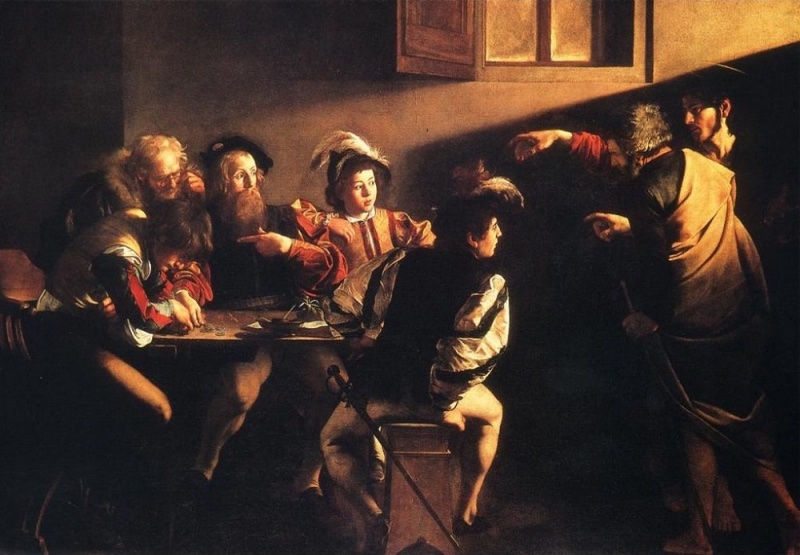
The Calling of St. Matthew, 1600. Caravaggio. Formality has given way to realism.
Towards the end of ‘Civilisation’ Clark narrates the following:
“Our other speciality is our urge to destruction. With the help of machines we did our best to destroy ourselves in two wars, and in doing so we released a flood of evil, which intelligent people have tried to justify with praise of violence, ‘theatres of cruelty’ and so forth. Add to this the memory of that shadowy companion who is always with us, like an inverted guardian angel, silent, invisible, almost incredible – and yet unquestionably there and ready to assert itself at the touch of a button; and one must concede that the future of civilisation does not look very bright.
And yet when I look at the world about me in the light of this series, I don’t at all feel that we are entering a new period of barbarism. The things that made the Dark Ages so dark -the isolation, the lack of mobility, the lack of curiosity, the hopelessness – don’t obtain at all. When I have the good fortune to visit one of our new universities, it seems to me that the inheritors of all our catastrophes look cheerful enough – very different from the melancholy late Romans or pathetic Gauls whose likenesses have come down to us. In fact, I should doubt if so many people have ever been as well-fed, as well-read, as bright-minded, as curious and as critical as the young are today.

La Baignade, Asnières, 1844. Seurat. Idealism and gentle abstraction
rear their heads. Newly industrialized Paris is visible in
the background.
Of course there has been a little flattening at the top. But one mustn’t overrate the culture of what used to be called ‘top people’ before the wars. They had charming manners, but they were as ignorant as swans. They did know something about literature, and a few had been to the opera. But they knew nothing about painting and less than nothing about philosophy (except for Balfour and Haldane). The members of a music group or an art group at a provincial university would be five times better informed and more alert. Naturally, these bright-minded young people think poorly of existing institutions and want to abolish them. Well, one doesn’t need to be young to dislike institutions. But the dreary fact remains that, even in the darkest ages, it was institutions that made society work, and if civilisation is to survive society must somehow be made to work.
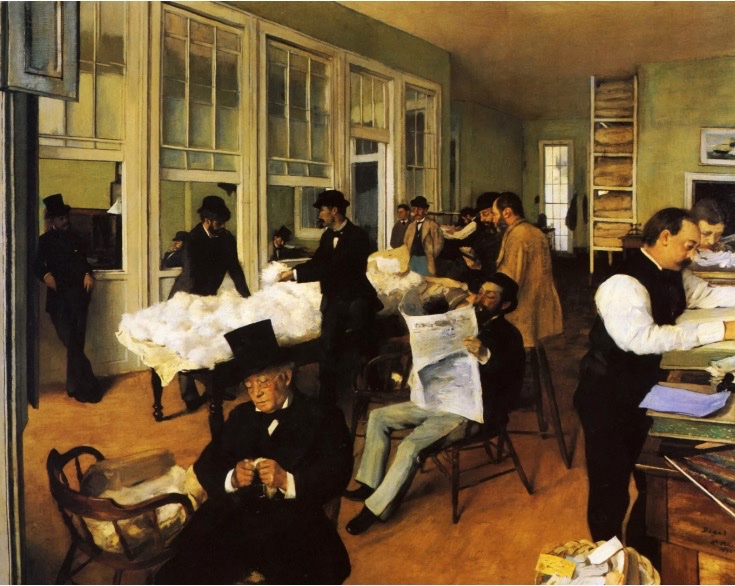
Degas: A Cotton Office in New Orleans, 1873. Early photographic vision.
Fifty years ago W. B. Yeats, who was more like a man of genius than anyone I have ever known, wrote a famous prophetic poem.
Things fall apart;
the centre cannot hold;
Mere anarchy is loosed upon the world,
The blood-dimmed tide is loosed,
and everywhere The ceremony of innocence is drowned;
The best lack all conviction,
while the worst are full of passionate intensity.
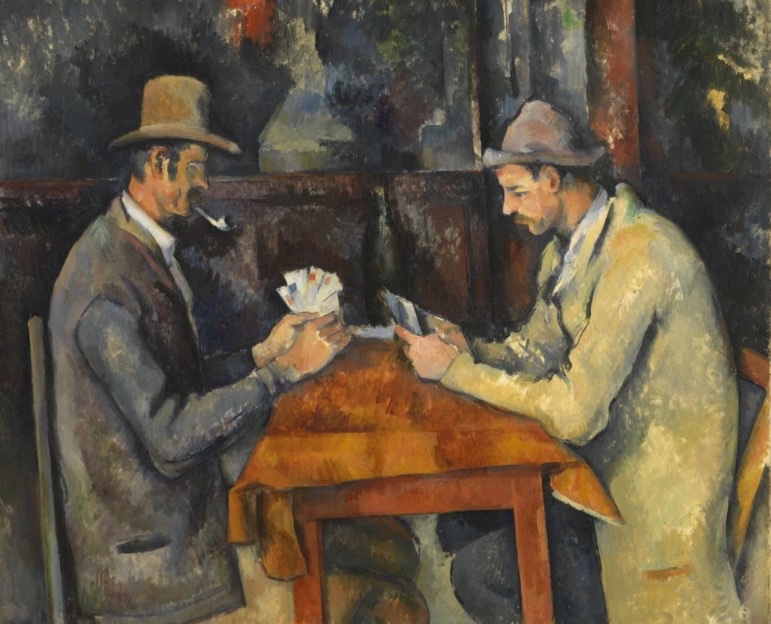
Cézanne, The Card Players, 1896, the painting
which paved the way for Picasso and cubism.
Well, that was certainly true between the wars, and it nearly destroyed us. Is it true today? Not quite, because good people have convictions, rather too many of them. The trouble is that there is still no centre. The moral and intellectual failure of Marxism has left us with no alternative to heroic materialism, and that isn’t enough. One may be optimistic, but one can’t exactly be joyful at the prospect before us.
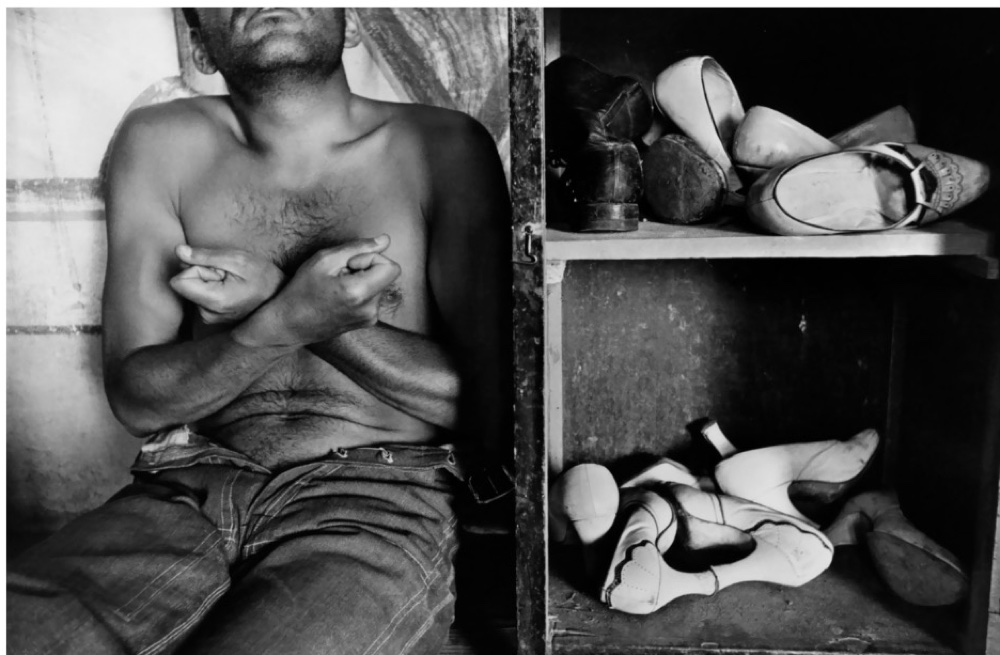
Henri Cartier-Bresson.
The Shoe Fetishist, Natcho Aguirre, Mexico, 1934.
The very height of surrealist photographic vision.
Magnificent prose. One wonders if he would be more despairing today, in an age of AI and control by a handful of US tech giants, intent on doing evil? And that intent, focused on depriving the individual of his pride and privacy, reducing all to the level of the gutter, has far more import on civilization than any terrorist attack.
But by opening my breadth of experience and my eyes and mind to the Renaissance and all it gave western culture, I will forever be grateful to Kenneth Clark.
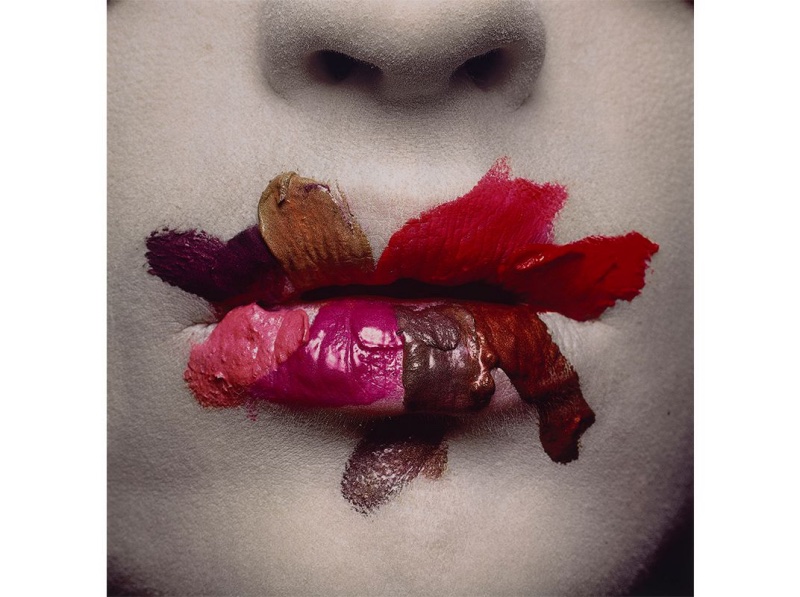
Mouth, Irving Penn. 1986. Crass, crude and utterly new.
A goodbye to civilization.
The DVD series of Civilisation is available from Amazon for very little. Fittingly the cover image is an extract of Raphael’s peerless School of Athens. It is unreservedly recommended to all civilized human beings or to those in search of what civilization means. When the series was first broadcast in the late 1960s it was proclaimed a resounding triumph with 5 million British and 10 million Americans tuning in. That’s 10% and 5%, respectively, of these nations’ populations, not a statistic consistent with claims to being civilized.
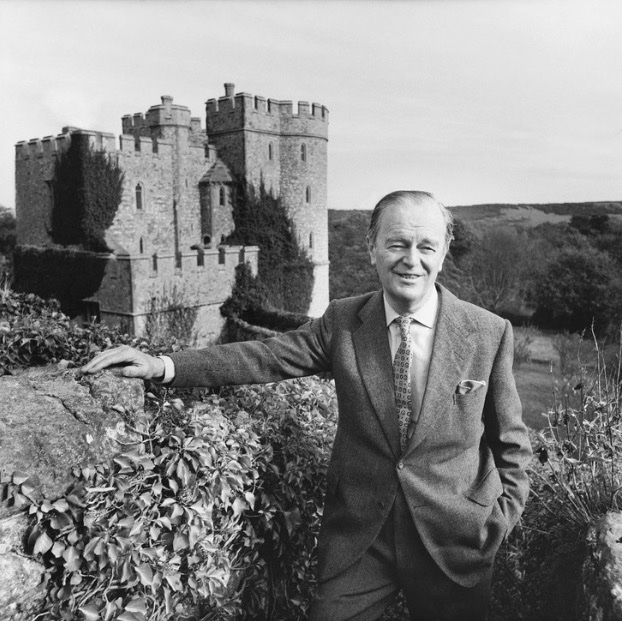
The man who helped me see, Kenneth Clark. Charm, erudition,
learning and passion. A truly civilized man.